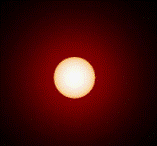Department of Physics and Astronomy: Publications and Other Research

Norman R. Simon Papers
Document Type
Article
Date of this Version
4-1968
Citation
THE ASTROPHYSICAL JOURNAL, Vol 152, April 1968
Abstract
The brightest blue supergiants represent the most massive evolved stars known. They are believed to be in the core helium-burning phase of evolution. To discuss the question of their stability, model interiors of core helium-burning stars with hydrogen-burning shells have been constructed and tested for pulsational instability (15-1000 M ʘ). All models are found to be extremely stable against nuclear-energized pulsations despite the high radiation pressure. Consequently, any star with mass less than the critically stable mass on the main sequence should evolve into the blue-supergiant region without disruption. By combining the theoretical calculations with the available observational data for the Large Magellanic Cloud, a self-consistent set of parameters may be obtained for the Large Cloud as follows: (1) the coincidence of the mass of the most luminous supergiants with the critical mass on the main sequence, (2) the occurrence of this mass at about 60 M ʘ, (3) a hydrogen abundance of X = 075 in the young Cloud population, and (4) a distance modulus of (m - M)0 = 18.7. We further verify theoretically the remarkable observed constancy of brightness of the most luminous B supergiants and their stability against disruption or large amounts of mass loss; any other kind of variability is likely to be due to atmospheric phenomena or to binary motion. The mass of the brightest Cepheids in the Magellanic Clouds is about 15 M ʘ. In our Galaxy, the most luminous supergiants known have inferred masses which do not significantly exceed the critical mass, nor is there any certain evidence for supermassiveness among the observed O stars.


Comments
Copyright 1968 American Astronomical Society